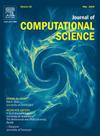A multiple sclerosis two-compartmental differential equation computational model 3D simulation using OpenCL
IF 3.7
3区 计算机科学
Q2 COMPUTER SCIENCE, INTERDISCIPLINARY APPLICATIONS
引用次数: 0
Abstract
Expanding on our previous conference paper (de Paula et al., 2023), this work introduces a novel two-compartmental 3D mathematical model based on differential equations to simulate Multiple Sclerosis (MS) dynamics. The mathematical model incorporates key MS processes like lymphocyte infiltration, antigen presentation, adaptive immune response activation, and demyelination. Implementing such a multi-scale, 3D problem is inherently complex. To address this, we utilised a heterogeneous computing environment combining CPUs and GPUs. However, this environment introduces load-balancing challenges. Initially, we tackled these challenges by employing two distinct load-balancing approaches to optimise simulation performance. Results reveal performance improvements of up to compared to the non-load-balanced version.

基于OpenCL的多发性硬化症双室微分方程计算模型三维仿真
在我们之前的会议论文(de Paula et al., 2023)的基础上,这项工作引入了一种新的基于微分方程的双室三维数学模型来模拟多发性硬化症(MS)动力学。该数学模型结合了MS的关键过程,如淋巴细胞浸润、抗原呈递、适应性免疫反应激活和脱髓鞘。实现这样一个多尺度的三维问题本质上是复杂的。为了解决这个问题,我们使用了一个结合了cpu和gpu的异构计算环境。然而,这种环境带来了负载平衡方面的挑战。最初,我们通过采用两种不同的负载平衡方法来优化模拟性能来解决这些挑战。结果显示,与非负载平衡版本相比,性能提高了4.4倍。
本文章由计算机程序翻译,如有差异,请以英文原文为准。
求助全文
约1分钟内获得全文
求助全文
来源期刊

Journal of Computational Science
COMPUTER SCIENCE, INTERDISCIPLINARY APPLICATIONS-COMPUTER SCIENCE, THEORY & METHODS
CiteScore
5.50
自引率
3.00%
发文量
227
审稿时长
41 days
期刊介绍:
Computational Science is a rapidly growing multi- and interdisciplinary field that uses advanced computing and data analysis to understand and solve complex problems. It has reached a level of predictive capability that now firmly complements the traditional pillars of experimentation and theory.
The recent advances in experimental techniques such as detectors, on-line sensor networks and high-resolution imaging techniques, have opened up new windows into physical and biological processes at many levels of detail. The resulting data explosion allows for detailed data driven modeling and simulation.
This new discipline in science combines computational thinking, modern computational methods, devices and collateral technologies to address problems far beyond the scope of traditional numerical methods.
Computational science typically unifies three distinct elements:
• Modeling, Algorithms and Simulations (e.g. numerical and non-numerical, discrete and continuous);
• Software developed to solve science (e.g., biological, physical, and social), engineering, medicine, and humanities problems;
• Computer and information science that develops and optimizes the advanced system hardware, software, networking, and data management components (e.g. problem solving environments).
 求助内容:
求助内容: 应助结果提醒方式:
应助结果提醒方式:


